Guido Reni
| Guido Reni | |
|---|---|
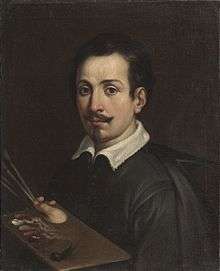 Self portrait, c. 1602 | |
| Born |
November 4, 1575 Bologna, Papal State |
| Died |
August 18, 1642 (aged 66) Bologna |
| Nationality | Italian |
| Known for | Painting |
| Movement | Baroque |
Guido Reni (4 November 1575 – 18 August 1642)[1] was an Italian painter of high-Baroque style.
Biography
Born in Bologna into a family of musicians, Guido Reni was the son of Daniele Reni and Ginevra de’ Pozzi. As a child of nine, he was apprenticed under the Bolognese studio of Denis Calvaert. Soon after, he was joined in that studio by Albani and Domenichino. He may also have trained with a painter by the name of Ferrantini. When Reni was about twenty years old, the three Calvaert pupils migrated to the rising rival studio, named Accademia degli Incamminati (Academy of the "newly embarked", or progressives), led by Lodovico Carracci. They went on to form the nucleus of a prolific and successful school of Bolognese painters who followed Lodovico's cousin Annibale Carracci to Rome. Like many other Bolognese painters, Reni's painting was thematic and eclectic in style.
Work in Rome
By late 1601, Reni and Albani had moved to Rome[2] to work with the teams led by Annibale Carracci in fresco decoration of the Farnese Palace. During 1601–1604, his main patron was Cardinal Paolo Emilio Sfondrati. By 1604–1605, he received an independent commission for an altarpiece of the Crucifixion of St. Peter. After a few year sojourn in Bologna, he returned to Rome to become one of the premier painters during the papacy of Paul V (Borghese). From 1607–1614, he was one of the painters patronized by the Borghese family.
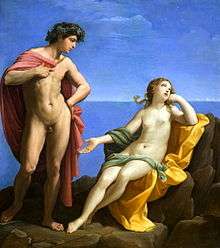
Reni's frescoed ceiling of the large central hall of garden palace, Casino dell'Aurora located in the grounds of the Palazzo Pallavicini-Rospigliosi, is considered his masterpiece. The casino was originally a pavilion commissioned by Cardinal Scipione Borghese;[3] the rear portion overlooks the Piazza Montecavallo and Palazzo del Quirinale.[4] The massive fresco is framed in quadri riportati and depicts Apollo in his Chariot preceded by Dawn (Aurora) bringing light to the world.[5] The work is restrained in classicism, copying poses from Roman sarcophagi, and showing far more simplicity and restraint than Carracci's riotous Triumph of Bacchus and Ariadne[6] in the Farnese. Reni in this painting allies himself more with the sterner Cavaliere d'Arpino, Lanfranco, and Albani "School" of mytho-historic painting, and less with the more crowded frescoes characteristic of Pietro da Cortona. There is little concession to perspective, and the vibrantly colored style is antithetical to the tenebrism of Caravaggio's followers. Payments showed that he was paid in 247 scudi and 54 baiocchi upon completion on 24 September 1616.
During Reni's years in Rome, two among Rome's most important and noble families were the Barberini and the Pamphilj; considering that Pope Urban VIII (Maffeo Barberini, 1568-1644) was a member of the former family, while among the cardinals was a member of the latter one, Giovanni Battista Pamphilj. The two families were in rather bad relations, and the reason for such friction was their constant quest for temporal power.
Also the Pope's brother, Antonio Barberini, was a cardinal, and he belonged to the Capuchin Order of Monks. In those days, the main church of the Capuchins in Rome was St.Nicholas' (now no longer extant), rather small and dating back to the Middle Ages. Therefore, soon after his election in 1635 Cardinal Barberini sponsored the making of a new, larger church for the Order he belonged to which became Santa Maria della Concezione dei Cappuccini, or Our Lady of the Conception of the Capuchins, and for one of its chapels a painting of Archangel Michael was commissioned to Reni.
"St Michael Archangel". The Archangel Michael trampling Satan,wears a late Roman military cloak and cuirass. 1636, held in Santa Maria della Concezione dei Cappuccini, Rome. According to a legend, Reni became aware that Cardinal Giovanni Battista Pamphilj had slandered him, or had offended his reputation in some way. So, Reni, sensing an opportunity, decided to avenge himself by means of his own talent, at the same time pleasing his client, who belonged to the opposing family. According to existing portraits of him, Cardinal Pamphilj had an elongated face, with thin hair, a scanty beard and a somewhat strange look in his eyes, that Reni judged perfect as a model for Satan. Therefore, the face that Archangel Michael crushes under his foot looks almost identical to that of Giovanni Battista Pamphilj. This turned out even more embarrassing a few years later, when in 1644 the cardinal was elected Pope Innocent X.
When the painting was hung in the church, the cardinal reputedly complained at such an outrage; Reni is said to have admitted to the amazing resemblance, but to have justified himself, claiming that Satan had appeared to him in a vision, thus he knew well his face, and if Cardinal Pamphilj was so unlucky to resemble him,he could not be blamed for this. So Giovanni Battista Pamphilj had to endure the shame of appearing portrayed as Satan[7][8]

He also frescoed in Paoline Chapel of Santa Maria Maggiore in Rome as well as the Aldobrandini wings of the Vatican. According to rumor, the pontifical chapel of Montecavallo (Chapel of the Annuciation) was assigned to Reni to paint. However, because he felt underpaid by the ministers, the artist left for Bologna, leaving the role of the preeminent artist in Rome to Domenichino.
Work in Naples and return to Bologna


In 1618, Reni traveled to Naples to complete a commission to paint a ceiling in a chapel of the San Gennaro.[9] However, in Naples, the other local prominent painters, including Corenzio, Caracciolo and Ribera, were vehemently resistant to competitors, and according to rumor, conspired to poison or otherwise harm Reni (as may have befallen Domenichino in Naples after him). He passed briefly by Rome, but left that city abruptly, during the pontificate of Urban VIII, after being reprimanded by Cardinal Spinola.
Returning to Bologna, more or less permanently, Reni established a successful and prolific studio. He was commissioned to decorate the cupola of the chapel of Saint Dominic in the Basilica of San Domenico in Bologna, between 1613 and 1615, resulting in the radiant fresco St Dominic's Glory, a masterpiece that can stand the comparison with the exquisite Arca di San Domenico below. He also contributed to the decoration of the Rosary Chapel in the same church with the Resurrection.
In Ravenna, he painted the chapel in the cathedral with his admired picture of the Israelites gathering Manna. Reni, after departing Rome, alternately painted in a variety of styles, true to the eclectic tastes of many of Carracci's trainees. For example, his altarpiece for Samson Victorious formulates stylized poses characteristic of Mannerism.[10] In contrast his Crucifixion and his Atlanta and Hipomenes[11] depict dramatic diagonal movement coupled with the effects of light and shade that portray the influence of Caravaggio. His turbulent and violent Massacre of the Innocents (Pinacoteca, Bologna) is painted in a manner reminiscent of Raphael. In 1625 Prince Władysław Sigismund Vasa of Poland visited the artist workshop in Bologna during his voyage to Western Europe.[12] The close rapport between the painter and the Polish Prince resulted in the acquisitions of drawings and paintings.[12] In 1630, he painted the Pallion del Voto with images of St. Ignatius and Francis Xavier, painted during the plague of 1630 that attacked Bologna.
His themes are mostly biblical and mythological in subject. He painted few portraits; those of Sixtus V, Cardinal Bernardino Spada, and the so‑called Beatrice Cenci are among the most noticeable. The identity of the Cenci portrait is very doubtful, since Beatrice Cenci was executed in Rome before Reni ever lived there and so could not have sat for the portrait. Many etchings are attributed to Guido Reni, some after his own paintings and some after other masters. They are spirited, in a light style of delicate lines and dots. Reni's technique was used by the Bolognese school and was the standard for Italian printmakers of his time.[13]
Reni died in Bologna in 1642. He is buried with Elisabetta Sirani in the Rosary Chapel of the Basilica of San Domenico in Bologna.
Pupils
Through his pupils, Reni had wide ranging influence on later Baroque. His most distinguished pupil was Simone Cantarini, named Il Pesarese; he painted a portrait of his master, now in the Bolognese Gallery. Other trainees were Antonio Buonfanti (il Torricello), Antonio Giarola (Cavalier Coppa), and Giovanni Battista Michelini. The Uffizi Gallery holds a self-portrait. Other pupils were Guido Cagnacci,[14] Giovanni Boulanger of Troyes,[15] Vincenzo Gotti of Bologna,[16] Emilio Savonanzi of Bologna,[17] Sebastiano Brunetti of Bologna,[18] Paolo Biancucci of Lucca,[19] Tommaso Campana of Bologna,[20] Domenico Maria Canuti of Bologna,[21] Pietro Ricci or Righi of Lucca,[22] Bartolomeo Marescotti of Bologna,[23] Pietro Lauri Monsu,[24] Giacomo Semenza,[25] Giovanni Maria Tamburino of Bologna,[26] Gioseffo and Giovanni Stefano Danedi,[27] Giovanni Giacomo Manno,[28] Carlo Cittadini of Milan,[29] Luigi Scaramuccia,[30] Bernardo Cerva,[31] Francesco Costanzo Cattaneo,[32] Francesco Gessi, Marco Bandinelli, and Pietro Gallinari in Bologna (Pierino del Signor Guido).[33]
Partial anthology of works
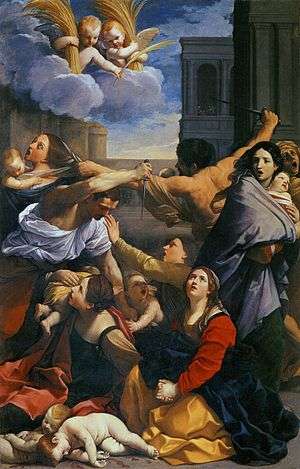
_02.jpg)
- Self-Portrait
- Callisto and Diana
- Crucifixion of St Peter, Vatican, Rome
- Christ Crucified, San Lorenzo in Lucina, Rome
- Holy Trinity, Santissima Trinità dei Pellegrini, Rome
- Conception, Forlì
- Alms of St. Roch, Bologna
- Massacre of the Innocents, Bologna
- Pietà, Bologna
- Penitent Magdalene ca. 1635, Walters Art Museum, Baltimore[34]
- Penitent Peter, Mabee-Gerrer Museum of Art, Shawnee, Oklahoma
- Lament over the Body of Christ, Chiesa dei Mendicanti, Bologna
- Ecce Homo, Gemaldegälerie, Dresden
- Saints Peter and Paul, Pinacoteca di Brera, Milan
- Assumption of the Virgin, Sant'Ambrogio, Genoa
- Assumption of Mary, Chiesa parrocchiale di Santa Maria, Castelfranco Emilia
- St. Paul the Hermit and St. Anthony in the Wilderness, Berlin
- Fortune, Capitol
- Samson Drinking from the Jawbone of an Ass
- Ariadne Capitoline Museums
- Atalanta and Hippomenes 1612 Prado, Madrid[35]
- Atalanta and Hippomenes 1622–25 Capodimonte, Naples[11]
- Madonna del Rosario, Pinacoteca, Bologna
- The Labors of Hercules, Louvre,
- The Suicide of Lucrezia ca. 1625-40 São Paulo Art Museum, São Paulo
- Lucrezia and Cleopatra, Pinacoteca Capitolina, Rome
- Annunziata Chapel, Quirinal Palace, Rome
- San Sebastiano, Pinacoteca, Bologna
- Saint Sebastian, Dulwich Picture Gallery; other versions are in the collections of the Cheltenham Art Gallery and Museum in the UK, the Palazzo Rosso in Genoa, the Capitoline Museum, the Louvre and at least 7 other known originals and multiple copies such as at the Kunsthistorisches Museum in Vienna.
- Saint John the Baptist in the Wilderness, Dulwich Picture Gallery
- Adoration of the Magi, Certosa di San Martino, Naples
- Judith, Birmingham Museum of Art, Birmingham, Alabama, United States
- Lotta di Putti, Galleria Doria Pamphilj, Rome
The Louvre contains twenty of his pictures, the National Gallery of London seven, and others once there have now been removed to other public collections. Among the seven is the small Coronation of the Virgin, painted on copper. It was probably painted before the master left Bologna for Rome.
Gallery
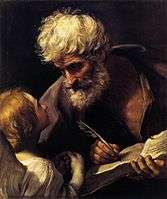 St Matthew and the Angel
St Matthew and the Angel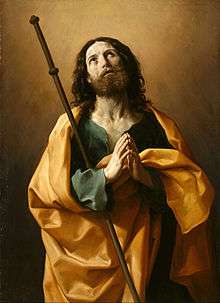 Saint James the Greater
Saint James the Greater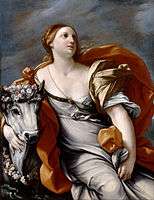 Europa and the Bull
Europa and the Bull Beatrice Cenci, sometimes ascribed to Elisabetta Sirani, which inspired Percy Shelley's play The Cenci
Beatrice Cenci, sometimes ascribed to Elisabetta Sirani, which inspired Percy Shelley's play The Cenci The Archangel Michael wears a late Roman military cloak and cuirass
The Archangel Michael wears a late Roman military cloak and cuirass The Baptism of Christ.
The Baptism of Christ.
 Hercules Vanquishing the Hydra of Lerma, ca. 1617 and 1620
Hercules Vanquishing the Hydra of Lerma, ca. 1617 and 1620 Jesus Christ with the cross
Jesus Christ with the cross St John the Baptist in the Wilderness
St John the Baptist in the Wilderness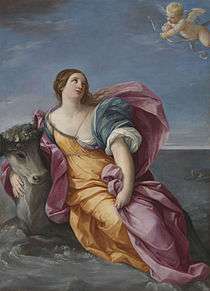 The Rape of Europa (1630s) at The National Gallery, London. Made for King Władysław IV of Poland.[36]
The Rape of Europa (1630s) at The National Gallery, London. Made for King Władysław IV of Poland.[36] Saint Cecilia
Saint Cecilia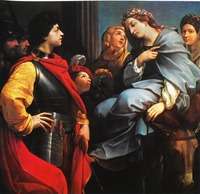 David and Abigail, religious biblical painting
David and Abigail, religious biblical painting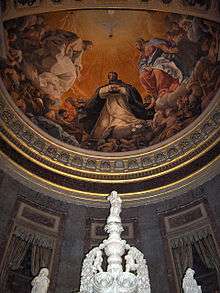 St Dominic's Glory crowning the Arca di San Domenico
St Dominic's Glory crowning the Arca di San Domenico.jpg)
References and sources
References
- ↑ oxfordartonline.com
- ↑ Guido Reni: A Review Reviewed,Stephen D. Pepper; Richard E. Spear. The Burlington Magazine (1990)132(10): p219-223.
- ↑ http://www.casinoaurorapallavicini.it/eng/index.htm
- ↑ "rome - Google Maps".
- ↑ "Aurora by RENI, Guido".
- ↑ Cara Lane/PETTT. "Image Files--Frescos".
- ↑ http://roma.andreapollett.com/S2/roma-c17.htm
- ↑ 257
- ↑ Pepper, S. (ed.) Guido Reni, 1575-1642, Los Angeles & Bologna: 1988.
- ↑ The victorious Samson (Wikicommons)
- 1 2 "Atalanta and Hippomenes by RENI, Guido".
- 1 2 "Kunstkammer of Władysław Vasa". kunstkammer_painting.html (in Polish). Retrieved 2008-08-27.
- ↑ "printmaking". Encyclopedia Britannica.
- ↑ Orlandi, Pellegrino Antonio; Guarienti, Pietro (1719), Abecedario Pittorico, Naples, p. 272
- ↑ Orlandi, page 207.
- ↑ Orlandi, page 425.
- ↑ Orlandi, page 136.
- ↑ Orlandi, page 398.
- ↑ Orlandi, page 469.
- ↑ Orlandi, page 416.
- ↑ Orlandi, page 128.
- ↑ Orlandi, page 378.
- ↑ Orlandi, page 83.
- ↑ Orlandi, page 335.
- ↑ Orlandi, page 245.
- ↑ Orlandi, page 249.
- ↑ Orlandi, page 197.
- ↑ Orlandi, page 308.
- ↑ Orlandi, page 102.
- ↑ Orlandi, page 307.
- ↑ Orlandi, page 93.
- ↑ Orlandi, page 90.
- ↑ Ticozzi, Stefano (1818). Dizionario degli architetti, scultori, pittori, intagliatori in rame ed in pietra, coniatori di medaglie, musaicisti, niellatori, intarsiatori d’ogni etá e d’ogni nazione (Volume 1). Vincenzo Ferrario, Milan. p. 220.
- ↑ "Browse the Collection". The Walters Art Museum · Works of Art.
- ↑ "Atalanta and Hippomenes by RENI, Guido".
- ↑ "The Rape of Europa". www.nationalgallery.org.uk. Retrieved 2008-08-27.
Sources
- Cavalli, Gian Carlo (ed.)Guido Reni exh. cat. Bologna 1954
- Pepper, Stephen, Guido Reni, Oxford 1984
- Marzia Faietti, 'Rome 1610: Guido Reni after Annibale Carracci' Print Quarterly, XXVIII, 2011, pp. 276–81
- Guido Reni 1575-1642 (exhibition catalogue Pinacoteca Nazionale, Bologna; Los Angeles County Museum of art; Kimbell Art Museum, Fort Worth) Bologna 1988
- Spear, Richard, The 'Divine' Guido: Religion, Sex, Money, and Art in the World of Guido Reni, New Haven and London, 1997
- Hansen, Morten Steen and Joaneath Spicer, eds., Masterpieces of Italian Painting, The Walters Art Museum, Baltimore and London, 2005
- "Printmaking". Encyclopædia Britannica. 2007. Encyclopædia Britannica Online. 29 March 2007
-
 This article incorporates text from a publication now in the public domain: Chisholm, Hugh, ed. (1911). "Guido Reni". Encyclopædia Britannica. 12 (11th ed.). Cambridge University Press.
This article incorporates text from a publication now in the public domain: Chisholm, Hugh, ed. (1911). "Guido Reni". Encyclopædia Britannica. 12 (11th ed.). Cambridge University Press.
External links
| Wikimedia Commons has media related to Guido Reni. |
| Wikisource has the text of the 1913 Catholic Encyclopedia article Guido Reni. |
- Orazio and Artemisia Gentileschi, a fully digitized exhibition catalog from The Metropolitan Museum of Art Libraries, which contains material on Guido Reni (see index)
- Jusepe de Ribera, 1591-1652, a full text exhibition catalog from The Metropolitan Museum of Art, which includes material on Guido Reni (see index)
- A poem about which models Guido Reni used for female subjects